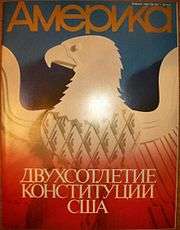Amerika (magazine)
|
1977 edition, dedicated to the 200th anniversary of the U.S. Constitution | |
| Editor-in-chief | Konstantin Borovoy |
|---|---|
| Year founded | 1944 |
| Final issue | 1994 |
| Country | USA |
| Language | Russian |
Amerika (Russian: "Америка") was a Russian-language magazine published by the United States Department of State during the Cold War for distribution in the Soviet Union. It was intended to inform Soviet citizens about American life.[1] Amerika was distinguished among other Soviet publications by its high-grade paper, bright printing and numerous photos. The magazine has been described as "polite propaganda" and featured high-quality photography and articles about everyday life in the United States, as well as profiles of famous American people and institutions.[2] Later it briefly existed as America Illustrated. 454 issues in total were published.
History
In 1944 the State Department began circulating 10,000 copies in the Soviet Union. The magazine was instantly popular and sold out all of its copies virtually overnight. In June 1947, the Soviet Union authorized an increase to 50,000 copies. By the late 1940s, the State Department began to feel that radio and the Voice of America would be more effective propaganda tools and, in 1952, publication of Amerika was suspended. However, in 1956, the American and Soviet governments agreed to exchange magazines and Amerika was reborn and published in return for distribution of The USSR in the United States.[3] The magazine was again an immediate success, selling out quickly. The goal, as explained in the first issue, was that "the Soviet reader could see the many-sided American life, reflected in it."
In his study of the propaganda of the era, University of Akron history professor Walter L. Hixson writes that Amerika was wildly popular among Soviet readers and notes that long lines would form when the magazine went on sale. Because the magazine sparked discussion among the Soviet intelligentsia and because each issue was widely shared, Amerika had impact and influence beyond its circulation of 50,000. The U.S. government felt that the magazine made a valuable contribution to better understanding of America by the Soviet people and was an effective counterpart to Soviet propaganda.
Sample articles published in Amerika include:
- A Skyscraper’s Walls Built in One Day, a photo-story showing how the walls of a tower block on Park Avenue, New York were completed in a period of just 10 hours
- A Young Farmer Harvests 1,165 Poods (1 pood = approx 36 lbs) of Corn from One Hectare of Land
- Examples of Cheap Furniture, showing home furnishings all of which were cheaper than $25
- Supermarkets – A New Era in Shopping
- The Automobile – Inside and Outside
- The War on Polio
- A Prosthetic Surgeon
- A School Where Children Learn the Science of Life
- A School in the Open Air
- How to Make a Dress Simply in One Day
- How to Score Points in Basketball
- America's 1956 Automobiles
- Fashions Under Twenty Dollars
- Best Dressed College Girls
- Television for the Millions
- Facts About the U.S.: The Negro Today
- Numerous articles about African-American jazz musicians
- Numerous articles about American artists[4][5]
The magazine ceased publication in October 1994.
"Amerika" is housed at many major research libraries in the U.S. Full runs of the Russian- and Polish-language editions, as well as translations of the articles and records related to their distribution, are available at the National Archives and Records Administration's Archives II facility in College Park, MD.
Notable contributors
From 1946 until 1952, Amerika was edited by Marion K. Sanders. The staff also included linguists Horace Lunt, David Simon (son of Solomon Simon) and Dick Burge.
Polish resistance fighter Antoni Koper edited Ameryka, the Polish language version of the magazine, from 1958 until he retired in 1972.[6]
Jane Jacobs worked for the magazine for many years, writing articles on American architecture, school planning, housing, slum clearance, and U.S. places and cities, presaging some of her work in The Death and Life of Great American Cities.[7]
References
- ↑ Creghton Peet: "Russian 'Amerika,' a Magazine about U. S. for Soviet Citizens", College Art Journal, Vol. 11, No. 1 (Autumn, 1951), pp. 17-20.
- ↑ Walter L. Hixson: Parting the Curtain: Propaganda, Culture, and the Cold War, 1945-1961 (McMillan, 1997), p. 118.
- ↑ http://www.bukovsky-archives.net/pdfs/usa/1200_us56-6-Eng-Olynyk.pdf
- ↑ Mike O’Mahony: Juvenile delinquency and art in Amerika, Art On The Line, 2004/1 (1)
- ↑ Hixson, p.118
- ↑ "Air Force Brigadier General Eugene A. Stalzer Dies at 70". The Washington Post. Retrieved 5 August 2016.
- ↑ Peter Laurence: Jane Jacobs Before Death and Life, The Journal of the Society of Architectural Historians / 66:1, March 2007
External links
- June 6, 1949 Time Magazine article concerning Amerika
- June 23, 1952 Time Magazine article concerning the demise of Amerika
